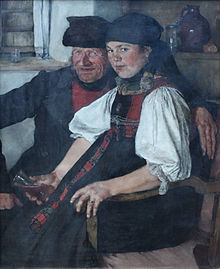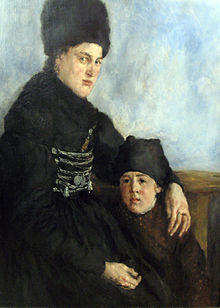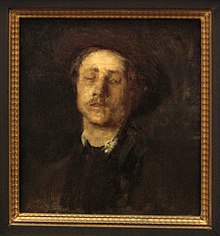Wilhelm Leibl

Wilhelm Maria Hubertus Leibl (born October 23, 1844 in Cologne ; † December 4, 1900 in Würzburg ) was an important representative of realism in Germany as a painter .
Life
Wilhelm Leibl was the fifth of six children of the Cologne cathedral music director Carl Leibl and his wife Maria Gertrud Lemper. Grandparents were Karl Ferdinand Leibl and Maria Regina Theresia Wagner from Landau and Jakob Lemper, professor at the Cologne High School Montanum , and Anna Catharina Franziska Blanck from Cologne.
Wilhelm Leibl left school early and received his first training after breaking off an apprenticeship as a locksmith with Hermann Becker in Cologne. From 1864 he studied at the Royal Art Academy in Munich with the teachers Hermann Anschütz , Alexander Strähuber , Arthur Georg von Ramberg and in 1868 with Carl Theodor von Piloty . In 1869 he shared a studio in Munich with the painters Theodor Alt, Rudolf Hirth du Frênes and Johann Sperl . The main work of this early period, the portrait of Frau Gedon (1868/69; Munich, Neue Pinakothek), brought him into friendly contact with Gustave Courbet . The Frenchman Courbet had attracted a lot of attention with his realistic pictures and their egalitarian surface structure. Leibl traveled to Paris for a short stay in 1870 , where he also got to know the painting of Édouard Manet .
In Munich in 1870 Leibl gathered like-minded painters, the Leibl Circle , around him ( Wilhelm Trübner , Carl Schuch , Theodor Alt , Karl Haider , and at times also Hans Thoma ). From 1873 Leibl withdrew from the Munich art business and lived with the painter Johann Sperl in Berbling and Bad Aibling in Upper Bavaria . In 1892 Leibl was appointed Royal Professor by Prince Regent Luitpold of Bavaria . In 1895 he received a great gold medal at the Great Berlin Art Exhibition .
Seriously suffering from heart disease and breathing difficulties, he went to Bad Nauheim for a cure in May / June 1900 and, when his disease worsened, to a Würzburg clinic, where he died of dropsy.
Quotes
"I have always worked and lived in the poorest of circumstances and had to bite away the anger of being misunderstood and despised of my views"
"Back, I have to die!"
Commemoration
His bust was displayed in the Hall of Fame in Munich. In 1931 the Wilhelm-Leibl-Gasse in Vienna - Hietzing was named after him and in 1950 the Leiblstieg in Hamburg-Groß Flottbek .
Wilhelm Leibl's grave is located in the main cemetery in Würzburg in Department I, 50 meters south of the funeral hall. His painter friend Johannes Sperl , who died in 1914, was buried in the same grave.
Services
Wilhelm Leibl is considered the most important painter of realism and a purely painting style in Germany. His pictures from the rural area of Upper Bavaria have nothing of idyll or genre-like narrative pleasure, but are characterized by the hardly embellished representation of the people. His detailed painting approached Impressionism from 1890, but he always preserved the cohesive physicality of his figures. Leibl was primarily a human actor.
Works


- Self-portrait as an eighteen-year-old Lower Saxony State Museum, Hanover 1862
- Head of a Blind Man , Lenbachhaus , around 1867–1869, oil on canvas
- Frau Gedon (Munich, Neue Pinakothek ), 1869, oil on canvas, 119.5 × 93.7 cm
- The young Parisian (Cologne, Wallraf-Richartz-Museum ), 1869, oil on panel, 64.5 × 52.5 cm (ill.)
- Sleeping Savoyard Boy (St. Petersburg, Hermitage ), 1869, oil on panel, 44 × 64 cm
- The painter Paul von Szinyei-Merse (Budapest, Szépmüvészeti Múzeum), 1869, oil on canvas, 139.5 × 102 cm
- The old Parisian (Cologne, Wallraf-Richartz-Museum), 1869–70, oil on panel, 81.5 × 64.5 cm
- The painter Sattler with his mastiff (Munich, Neue Pinakothek), 1870, oil on panel, 72.5 × 62 cm
- Concert study (Cologne, Wallraf-Richartz-Museum), around 1870, oil on wood, 44 × 40 cm
- Johann Heinrich Pallenberg (Cologne, Wallraf-Richartz-Museum), 1871, oil on canvas, 118 × 95.5 cm
- Lina Kirchdorffer (Munich, Neue Pinakothek, inv.no.8446), 1871, oil on canvas, 111.5 × 83.2 cm
- Dachau woman with child (Berlin, Alte Nationalgalerie ), 1874–75, oil on panel, 86 × 68 cm
- Two Dachau women in an inn ( Hamburg, Art Museum), 1874–75
- The painter Carl Schuch (Munich, Neue Pinakothek, Inv. No. 8620), 1876, oil on canvas, 58.6 × 50.5 cm
- Peasant girl with a white headscarf (Munich, Neue Pinakothek), around 1876, oil on panel, 21.5 × 17 cm
- The unequal couple (Frankfurt, Städelsches Kunstinstitut ), 1876–77, oil on canvas, 75.5 × 61.5 cm
- Die Dorfpolitiker (Winterthur, Oskar Reinhart Collection ), 1877, oil on canvas on wood, 76 × 97 cm
- Rosina Fischler, Countess Treuberg (Vienna, Austrian Gallery , inv.no.1497), 1877, oil on panel, 88 × 66.8 cm
- Der Spargroschen (Wuppertal, Von der Heydt-Museum ), 1877, oil on wood, 39 × 31 cm
- Dr. med. Friedrich Rauert ( Hamburger Kunsthalle ), 1877, tempera on canvas, 50 × 40 cm
- Rosine Fischler, Countess Treuberg (Hamburg, Kunsthalle), 1877–78, oil on canvas, 104.1 × 82.2 cm
- Head of a peasant girl (Dresden, Gemäldegalerie), 1879, oil on panel, 31 × 24 cm
- Girl's head (Dachauerin) , 1879. Alte Nationalgalerie Berlin, oil on panel, 20 × 16 cm
- Head of a Peasant Girl (Vienna, Austrian Gallery, Inv. No. 594), around 1880, oil on panel, 30 × 27.5 cm
- Girl with the Carnation , Staatliche Kunsthalle Karlsruhe , around 1880, oil on panel
- The three women in the church (Hamburg, Kunsthalle), 1881, oil on panel, 113 × 77 cm
- Die Wildschützen (Berlin, Alte Nationalgalerie ), 1882–86, oil on canvas, 55 × 42 cm
- In the Bauernstube (Munich, Neue Pinakothek), 1890, oil on panel, 37 × 38 cm
- The veterinarian Dt. Reindl in der Laube (Munich, Städtische Galerie im Lenbachhaus ), around 1890, oil on panel, 26 × 19.5 cm
- Julius Mayr (Schweinfurt, Georg Schäfer Museum ), 1890
- Auguste Mayr (missing), 1891
- Leibl and Sperl on the Chicken Hunt (Munich, Neue Pinakothek), 1890–95, oil on canvas, 40 × 58 cm
- The newspaper reader (Essen, Museum Folkwang ), 1891, oil on canvas, 63 × 48.5 cm
- The Spinner (Leipzig, Museum of Fine Arts ), 1892, oil on canvas, 65 × 74 cm
- Girls knitting on the stove bench (Dresden, Gemäldegalerie), around 1892–95, oil on canvas, 59 × 42 cm
- Girl at the stove (Cologne, Wallraf-Richartz-Museum), 1895, oil on panel, 41 × 32 cm
- Miesbacher peasant woman (Wuppertal, Municipal Museum), around 1896, oil on panel, 37 × 29 cm
- In expectation (Leipzig, Museum der bildenden Künste), 1898, oil on panel, 35 × 26.5 cm
- In the kitchen (Cologne, Wallraf-Richartz-Museum), 1898, oil on canvas, 84 × 64.5 cm
- Girl at the Window (Cologne, Wallraf-Richartz-Museum), 1899, oil on canvas, 109 × 72 cm
literature
- Götz Czymmek, Christian Lenz (Ed.): Wilhelm Leibl on the 150th birthday . Exhibition catalog, Neue Pinakothek Munich, Wallraf-Richartz-Museum Cologne. Edition Braus, Heidelberg 1994.
- Marcus Dekiert, Roland Krischel (ed.): From human to human - Wilhelm Leibl & August Sander . Hirmer, Munich 2013, ISBN 978-3-7774-2042-4 .
- Armin Jüngling, Klaus Müller-Brunke: Wilhelm Leibl - A picture journey through a life . Mahnert-Lueg, Munich 1986, ISBN 3-922170-48-X .
- Alfred Langer: Wilhelm Leibl (painter and work) . Verlag der Kunst, Dresden 1979.
- Marianne von Manstein / Bernhard von Waldkirch: Wilhelm Leibl. Seeing is everything! Munich: Hirmer 2019, ISBN 978-3-7774-3386-8 .
- Julius Mayr : Wilhelm Leibl. His life and work. Cassirer, Berlin 1906; 2nd edition 1914; 3rd edition 1919; 4th edition Verlag F. Bruckmann, Munich 1935.
- Michael Petzet (Ed.): Wilhelm Leibl and his circle . Exhibition catalog. Lenbachhaus, Munich 1974.
- Boris Röhrl: Wilhelm Leibl - life and work . (= Studies on Art History , Vol. 85), Georg Olms, Hildesheim, Zurich 1994, ISBN 3-487-09965-9 .
- Boris Röhrl (Ed.): Letters Wilhelm Leibl 1844–1900. Letters with historical-critical commentary . Georg Olms, Hildesheim 1996, ISBN 3-487-10164-5 .
- Eberhard Ruhmer : Leibl, Wilhelm. In: New German Biography (NDB). Volume 14, Duncker & Humblot, Berlin 1985, ISBN 3-428-00195-8 , pp. 119-121 ( digitized version ).
- Eberhard Ruhmer: The Leibl circle and pure painting . Rosenheimer, Rosenheim 1994, ISBN 3-475-52455-4 .
- Klaus J. Schönmetzler: Wilhelm Leibl and his painter friends . 2nd Edition. Rosenheimer, Rosenheim 2014, ISBN 978-3-475-54225-1 .
- Beate Söntgen: Seeing is everything - Wilhelm Leibl and the perception of realism . Wilhelm Fink, Munich, 2000, ISBN 3-7705-3433-6 .
- Emil Waldmann : Wilhelm Leibl. Published by EA Seemann, Leipzig 1921.
Web links
- Literature by and about Wilhelm Leibl in the catalog of the German National Library
- Works by Wilhelm Leibl at Zeno.org .
- Wilhelm Leibl - Everything is good to see! Albertina, Vienna until May 10, 2020
Individual evidence
- ↑ a b Willi Dürr Nagel: Wilhelm Leibl. In: Würzburger Anzeiger. September 2012, p. 3.
- ↑ Rita Bake : A Memory of the City. Streets, squares, bridges named after women and men , Volume 3, as of December 2017, p. 830 ( PDF file )
- ↑ Willi Dürr Nagel: Wilhelm Leibl. In: Würzburger Anzeiger. September 2012, pp. 1–3.
| personal data | |
|---|---|
| SURNAME | Leibl, Wilhelm |
| ALTERNATIVE NAMES | Leibl, Wilhelm Maria Hubertus (full name) |
| BRIEF DESCRIPTION | German painter |
| DATE OF BIRTH | October 23, 1844 |
| PLACE OF BIRTH | Cologne |
| DATE OF DEATH | 4th December 1900 |
| Place of death | Wurzburg |




